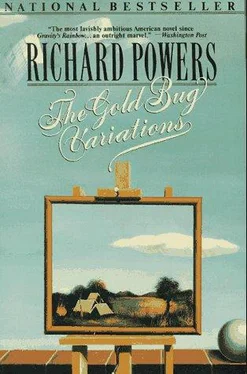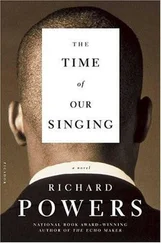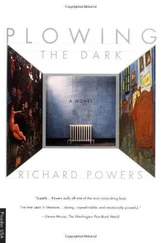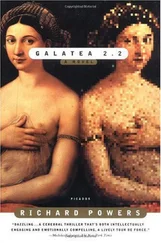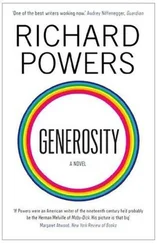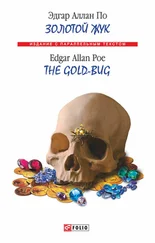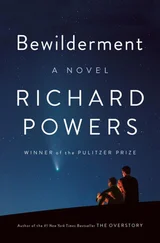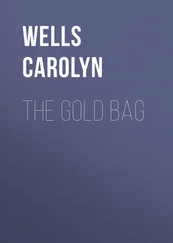Richard Powers - Gold Bug Variations
Здесь есть возможность читать онлайн «Richard Powers - Gold Bug Variations» весь текст электронной книги совершенно бесплатно (целиком полную версию без сокращений). В некоторых случаях можно слушать аудио, скачать через торрент в формате fb2 и присутствует краткое содержание. Год выпуска: 1991, Издательство: Harper Perennial, Жанр: Современная проза, на английском языке. Описание произведения, (предисловие) а так же отзывы посетителей доступны на портале библиотеки ЛибКат.
- Название:Gold Bug Variations
- Автор:
- Издательство:Harper Perennial
- Жанр:
- Год:1991
- ISBN:нет данных
- Рейтинг книги:5 / 5. Голосов: 1
-
Избранное:Добавить в избранное
- Отзывы:
-
Ваша оценка:
- 100
- 1
- 2
- 3
- 4
- 5
Gold Bug Variations: краткое содержание, описание и аннотация
Предлагаем к чтению аннотацию, описание, краткое содержание или предисловие (зависит от того, что написал сам автор книги «Gold Bug Variations»). Если вы не нашли необходимую информацию о книге — напишите в комментариях, мы постараемся отыскать её.
Gold Bug Variations — читать онлайн бесплатно полную книгу (весь текст) целиком
Ниже представлен текст книги, разбитый по страницам. Система сохранения места последней прочитанной страницы, позволяет с удобством читать онлайн бесплатно книгу «Gold Bug Variations», без необходимости каждый раз заново искать на чём Вы остановились. Поставьте закладку, и сможете в любой момент перейти на страницу, на которой закончили чтение.
Интервал:
Закладка:
She talked for the first time about her father, the third child from the right in front of the shaft entrance in a famous photo of child mine workers. Now Ressler has never harbored closet Lamarckism; social traumas experienced by the forefathers are not visited upon the sons. But his grandfather's life underground left its imprint — the dream of meliorism that child laborers impart rose up from his mother's lungs on the warm tufts of her disease. Suffering, her last looks said to him, must be the precursor to greater things. Every rung goes higher and higher.
She died ten days after his return to school. In a misguided final tribute to her son, she left her body to medical science," meaning, Stuart knew, that third-year premeds lopped her organs off in anatomy lab. Because he never saw her body again, she did not die until this evening, when Evie Blake assigns her a number. He always knew the world would one day be like this: a night of no temperature, sitting outside with no one there any longer to call him in. Free to sit forever in the company of strangers, in the belly of a cold, formless waiting.
The Blakes, seeing they have accidentally sent their host off alone, call it a night and take their leave back to K-53-A. But they read him wrong. Ressler comes back to the lawn party, wanting them to resume the careless evening, extend it, stretch out the mixed blessing of companionship until morning. But searching, he cannot find the pointer to the words "Don't go yet." The Blakes disappear, waving, across the lawn. He cannot even find those two syllables for a departing greeting. Minutes later he remembers it: "Good night." Come back. Good night.
Landscape with Conflagration
I've reached a sticking point in my homework, the background reading that must take me inside the man. Not a barrier to comprehension: I remember, flexing my intellect again this season, that given time, I have the capacity to tackle anything, however formidable. And I have more than enough time — time spreading from sunny sahara mornings alone over onion bagels and oranges to arctic nights, postponing sleep as long as possible, armed with only thick books and a headboard lamp. I've hit a barrier not to comprehension but to credulity. How can an assortment of invisible threads inside one germ cell record and pass along the construction plans of the whole organism, let alone the cell housing the threads themselves? I've grasped the common metaphor: the blueprint gene somehow encodes a syntactic message, an entire encyclopedia of chemical engineering projects. I feel the thrill of attaching abstract gene to physical chromosome. But it remains analogy, lost in intermediary words.
The task Dr. Ressler set himself was merely — and only he could have thought "merely" — to capture the enigma machine that tweaks this chromosomal message into readability. Did he believe that nothing was lost in translation as signals percolated up from molecules in the thread into him, that brain, those limbs, that hurt, alert face? Searching for his own lexicon required faith that the chemical semaphore could serve as its own rosetta, faith that biology too could be revealed through its particulars. Faith that demonstration could replace faith.
It grows like a crystal, this odd synthesis of evolution, chemistry, and faith, spreads in all directions at once, regular but aperiodic. By Ressler's birth, enzymes — catalysts driving the chemical reactions of metabolism — were identified as proteins. The structure of proteins — responsible for everything from the taste of sole to the toughness of a toenail — strikes me as ridiculously simple: linear, crumpled necklaces of organic pearls called amino acids. What's more, the protein necklaces directing all cell processes consist of series of only twenty different amino acid beads.
It seems impossible: twenty can't be sufficient word-hoard to engineer the tens of thousands of complex chemical reactions required to make a thing live. But lying in bed under my arctic nightlight, carrying out the simple arithmetic, I see how the abject simplicity of protein produces more potential than mind can penetrate. A necklace of only two beads, each in one of twenty colors, can assume any of four hundred different combinations. A third bead increases this twenty times — eight thousand possible necklaces. I learn that the average protein necklace floating in the body weighs in at hundreds of beads. At that length, the possible string combinations exceed the printed sentences in man-made creation. Room to grow, in other words.
The protein bead string folds up, forms secondary structures determined by its amino acid sequence. The shape of these fantastic landscapes, fuzz-motes as convoluted as the string is simple, gives them their specific, chemical power. Their jungle of surface protrusions provides — like so many dough forms — niches for other chemicals to assemble and react.
But if these cookie cutters — in countless possible fantastically complex shapes — build the body, what builds the builders? The answer appalls me. The formula for the builder molecules as well as its implementation are contained in another long, linear molecule. This time the beads come in only four colors. It says something about my progress in scientific faith that I accept the calculation showing that the possible combinations in one such foursquare informational molecule exceed the total number of atoms in the universe.
But I hang up on the idea of such a linear molecule encoding a breathing, hoping, straining, failing, aging, dying scientist. I find as I read that I'm in good company. If I still ran the Quote Board, I'd use tomorrow that gem of Einstein's when meeting Morgan and hearing of his project to mechanize biology:
No, this trick won't work— How on earth are you ever going to explain in terms of chemistry and physics so important a biological phenomenon as first love?
But I no longer run the Quote Board. I run nothing now except the Jan O'Deigh Continuing Education Project. And for that, I have only more history. When counting aminos fails to put me to sleep, I charm insomnia by reading Beadle and Tatum's 1940 work on the bread mold Neurospora. Only seventeen years old when Ressler got his brainstorm, it must have read like a classic to a student raised on it. While the world once more indulged its favorite occupation, Beadle and Tatum dosed mold with X-rays to induce mutations. Raising thousands of test-tube strains, they produced mutants that could no longer manufacture required nutrients. Mutated chromosomes failed to produce necessary enzymes.
With an excitement that penetrates even the sober journal account, they crossed a mutant that could no longer make enzyme E with its normal counterpart. Half the offspring had the mutation and half did not. Enzyme production precisely mirrored Mendelian inheritance. One gene, one enzyme. Each time I read the conclusion, I hear his perverse question: "What could be simpler?"
A unique gene, coding for a unique enzyme: Cyfer inherited as dogma what actually arose only through recent, bitter debate. The limited informational content of DNA — the four bases adenine, guanine, cytosine, and thymine — did not seem adequate to build the fantastically varied amino acid necklaces. For some time, the size of DNA was underestimated, and even after the enormous molecular weight was correctly determined, many scientists believed that the four bases followed one another in repeating order. Redundant series carry no more information than a news program repeating, "Earlier today, earlier today__"
DNA was long rejected as the chromosomal message carrier. Some researchers believed that proteins themselves were the master blueprint, even though every protein would require others to build it. Avery blazed the trail out of confusion. His 1944 paper showed that the substance transforming one bacterial strain to another was not protein but DNA. Inheritance was rapidly being reduced from metaphor to physical construct. DNA was a plan that somehow threaded raw amino acid beads into proteins. These protein chains in turn catalyzed all biological process. Cyfer's question — the coding problem — was how a long string of four types of things stood for thousands of shorter, twenty-thing strings.
Читать дальшеИнтервал:
Закладка:
Похожие книги на «Gold Bug Variations»
Представляем Вашему вниманию похожие книги на «Gold Bug Variations» списком для выбора. Мы отобрали схожую по названию и смыслу литературу в надежде предоставить читателям больше вариантов отыскать новые, интересные, ещё непрочитанные произведения.
Обсуждение, отзывы о книге «Gold Bug Variations» и просто собственные мнения читателей. Оставьте ваши комментарии, напишите, что Вы думаете о произведении, его смысле или главных героях. Укажите что конкретно понравилось, а что нет, и почему Вы так считаете.
